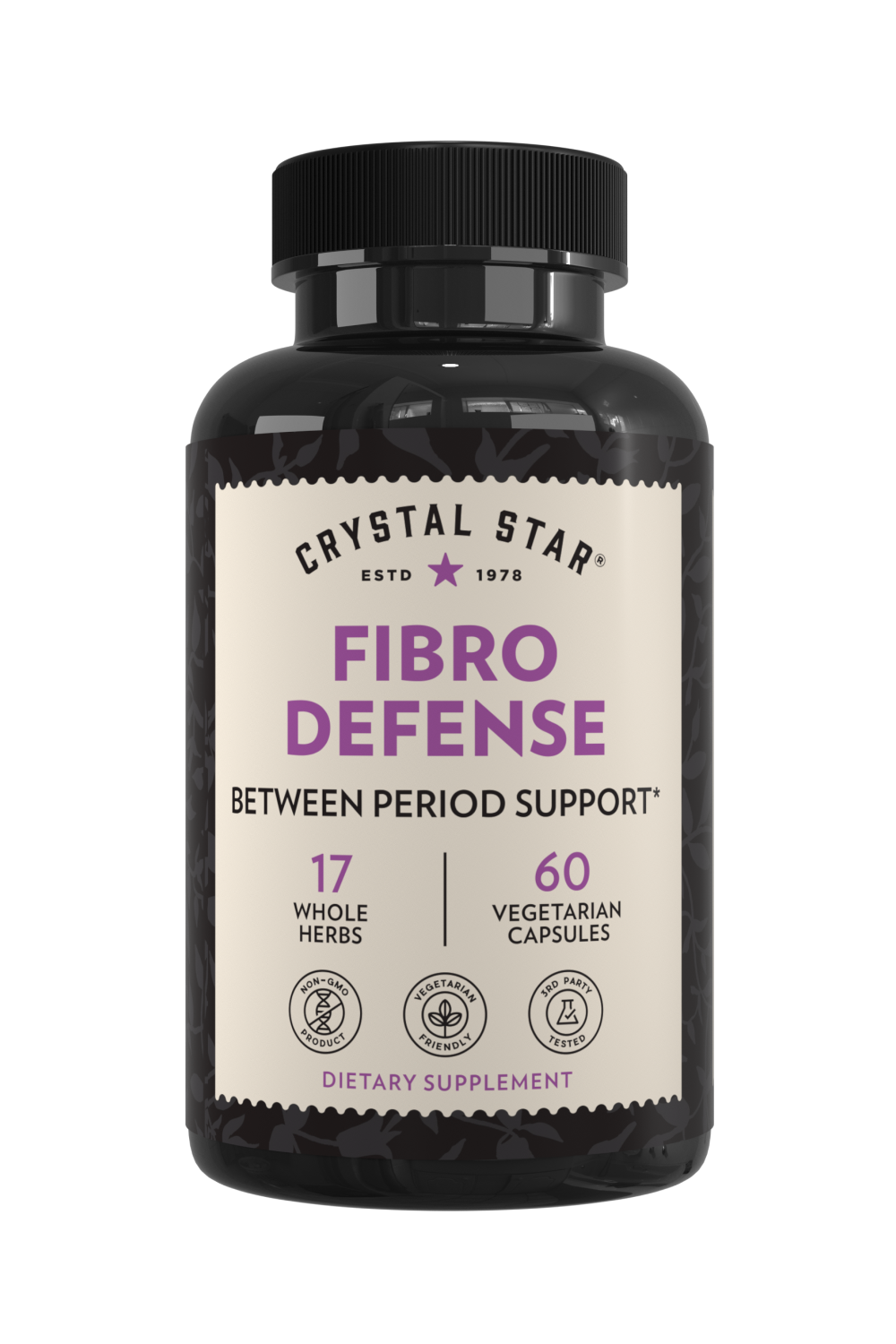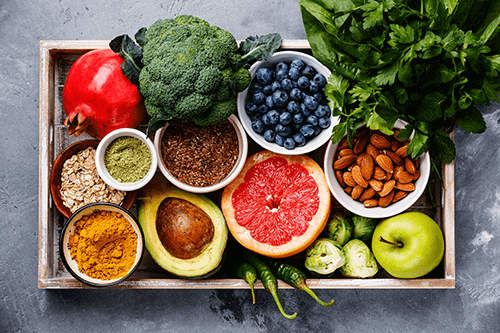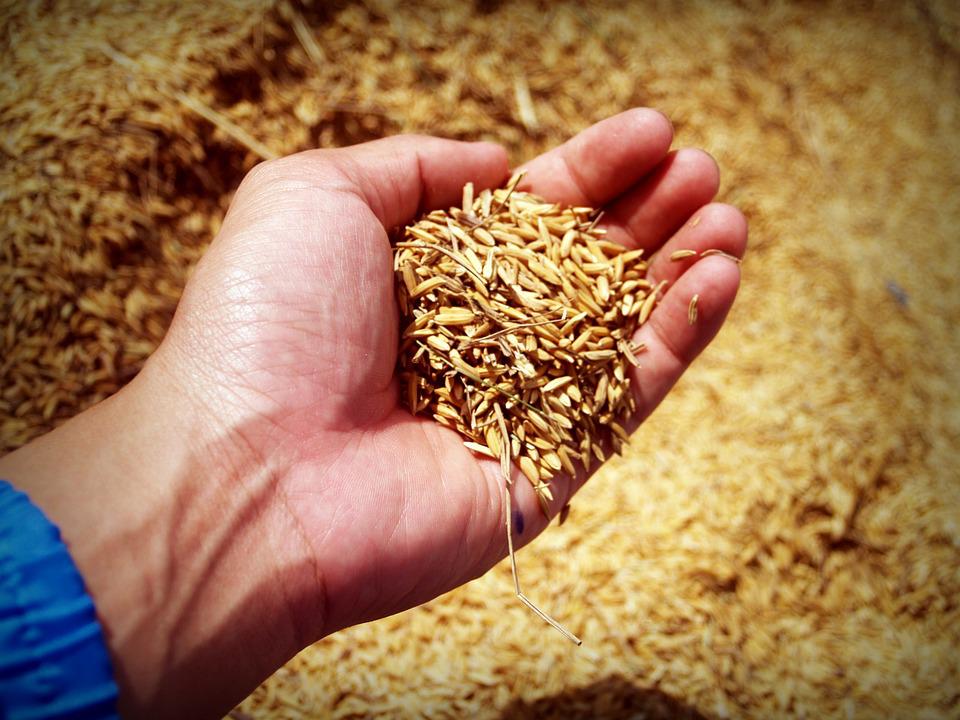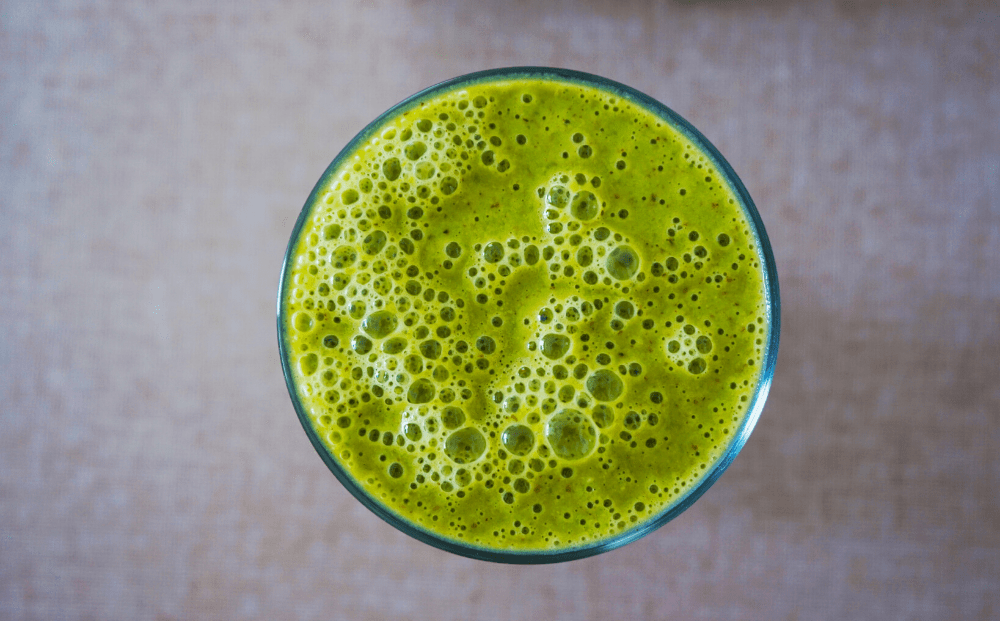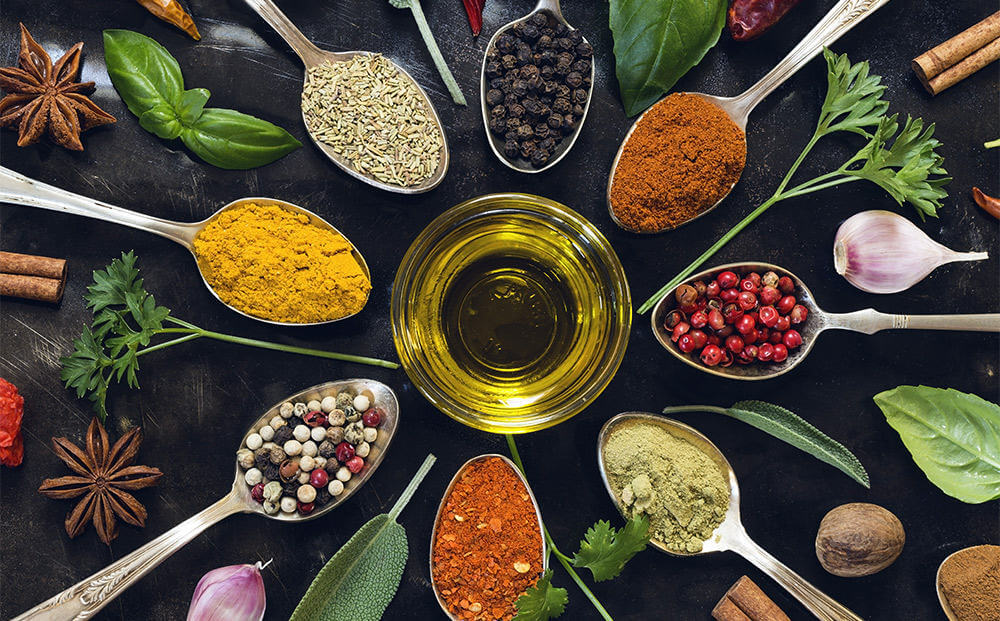
We use herbs all the time. So what the heck are they?
Herbs: you keep them in your refrigerator, spice rack, and medicine cabinet. But have you ever stopped to wonder—perhaps while sipping a mug of chamomile tea—what exactly are herbs, anyway?
The health-boosting power of herbs has been known for hundreds of years. In the 8th century, Charles The Great called herbs “the friend of physicians and the praise of cooks.” (1) That sentiment holds true today, but we now have more understanding of the science behind herbs’ powers.
WHAT ARE HERBS?

Let’s start with the botanical definition of herbs.
Herbs are the edible leaves, flowers, or roots of certain herbaceous plants, which are plants that are defined by their lack of above-ground woody stems. Herbaceous plants include herbs, grasses, and ferns, while non-herbaceous plants include trees, shrubs, and woody bamboo.
In the kitchen, the word “herb” is often used for anything green you can use to season your dish. There are kitchen herbs that don’t fit the botanical definition of herbs. These include rosemary, sage, thyme, ( woody shrubs) and bay leaves, which come from the bay laurel tree.
In the wellness world, the word “herb” is even squishier and can include sea greens, mushrooms, spices, or other parts of non-herbaceous plants, including fruits.
WHY DO WE USE HERBS?
Science aside, in the everyday sense herbs are ingestible plants we use to flavor food and heal ourselves.Herbs are prized for their savory, nutritional, medicinal, and aromatic properties. They’re commonly available both fresh and dried, and can be found on ingredient labels ranging from canned tomatoes to herbal shampoo.
Many herbs are surprisingly multifunctional. Chopped parsley adds color and freshness to roast potatoes or chicken piccata. But did you know that parsley is also being studied for its capacity to treat some autoimmune and allergic diseases?(2)
Parsley is just the tip of the iceberg salad. Flavor lovers rejoice, because herbs and health go hand-in-hand.
It turns out that just about every important herb and spice in a chef’s pantry is also fantastically healthy. Garlic? It can lower blood pressure.(3) Basil? Both an antioxidant and anti-inflammatory.(4) Rosemary? It helps inhibit seasonal allergies.(5)
And if you’re feeling thirsty, bottom’s up. According to a 2018 review of herbal beverages, they contain antioxidant properties and may reduce overall risk of disease.(6) Something to contemplate while sipping your next mug of tea—be it peppermint, ginger, or rooibos.
That said, many medicinal herbs can be used topically (or shouldn’t be ingested). Soaking in herbal baths has long been done for relaxation and rejuvenation. Lavender is commonly used in aromatherapy for its calming effects. Hemp lotion is gaining popularity as a natural moisturizer, and red clover(7) has been studied to improve skin health—to name just a few.
ARE HERBS VEGETABLES?
Sort of. Like vegetables, scientifically-defined herbs are edible roots, leaves, or stalks of an herbaceous plant. The only thing differentiating herbs from vegetables is that vegetables are the main event of a meal, and herbs (with some exceptions) are used for therapeutic purposes or to flavor meat and vegetables.In other words, vegetables provide the bulk of macronutrients like protein and carbohydrates in your meal, while more sparsely-used herbs contributed additional micronutrients (vitamins, minerals) and bioactive compounds (health-promoting chemicals).
To recap: botanically-defined herbs and vegetables are both the edible roots, stems, or leaves of an herbaceous plant. The difference between them is in how and why we consume them, as well as the more concentrated bioactive compounds (like antioxidants) found in some herbs.
ARE HERBS NUTRITIOUS?

often contain even more vitamins and minerals than typical leafy greens. Herbs are also low in calories, fat, and sodium. Herbs are both healthy on their own and can be used to make reduced fat foods taste better.(8)
So, how do common herbs compare to leafy greens?
One hundred grams of spinach, for example, contains 23 calories per the USDA.(9) This is about 3.5 ounces, or a large handful from the bag. Spinach is an excellent source of calcium, folate, iron, fiber, and Vitamins A, C and K, all while being low in calories, fat, and sodium.
The same weight of basil contains as many calories as spinach: 23. Basil is similar to spinach in iron and Vitamin K. It has nearly twice the calcium as spinach but slightly less Vitamin A and folate. Basil contains far less sodium than spinach: 4 mg vs. 79 mg.
What about parsley? One hundred grams may be a bunch or two of parsley, depending on how generous your grocery store is. That amount contains 36 calories. While similar to spinach in some ways, parsley boasts more than twice the iron content, as well as more than three times as much Vitamin K.
Fresh thyme is one of the more nutritionally surprising herbs—by weight it has over three times the Vitamin C of oranges. 100 grams thyme contains 160.1 mg of Vitamin C while oranges have 45 mg. While it’s rare to eat fresh thyme by the bushel, it’s good to know that cooking with herbs adds a nutritional punch that goes beyond flavor.
WHAT ARE CULINARY HERBS?

Dried herbs are convenient and practical. They are often added during the cooking process whereas fresh herbs are added at the end of cooking to preserve their delicate flavor and texture.

The drying process concentrates flavor and extends shelf life. Rather than wilting in the fridge, dried herbs keep their potency for a year or more. Dried herbs are healthy but may have a slightly different nutritional profile from their fresh counterparts.(10)
When comparing equal amounts by weight, dried herbs typically contain more antioxidant capacity than fresh.(11) Vitamin content, on the other hand, is often higher in fresh herbs. (12)
When substituting dried herbs for fresh, Martha Stewart, among others, recommends using one-third of the amount due to their concentrated flavor. (If a recipe calls for 3 teaspoons fresh rosemary, use 1 teaspoon dried.)
ARE HERBS DIFFERENT FROM SPICES?
In culinary terms, yes, herbs are different from spices. Herbs are green plant leaves or stems only, while spices come from other parts of the plant, such as the bark, roots, berries, seeds, or flower buds.Some common spices include cinnamon (dried bark), cumin (dried seeds), cloves (dried flower buds) and ginger (both a root vegetable and honorary spice because of its flavor wallop).
Some plants also produce both herbs and spices. For example, we have the Coriandrum sativum plant to thank for the herb cilantro (fresh leaves) and the spice coriander (dried seeds).
While the cooking world differentiates herbs from spices, in the wellness work both are often simply called herbal (or plant-based) supplements. They’re often lumped in with the natural foods category and tout similar health-boosting benefits.
WHAT ARE MEDICINAL HERBS?

You can also find herbal supplements in the form of pills, oils, topical creams, and tea. Some culinary herbs are also used for medicinal purposes. Garlic packs a lot of flavor, for example, but some people also use garlic in supplement form to support cardiovascular health.(14)
If you’ve ever relaxed with a mug of chamomile tea you’re already familiar with another culinary-medicinal crossover that has been used for thousands of years. Its calming effects are well established, and today we understand the science of why: it contains the compound apigenin, a natural antioxidant that may also have sedating effects.(15)
Over a million cups of chamomile are consumed every day.(16)
WHAT MAKES AN HERB MEDICINAL?
Like chamomile, which looks like a daisy, there are plants and plant parts that have been known for thousands of years to support overall health. Medicinal herbs have long been used in traditional Chinese medicine, Indian Ayurvedic practice, and by the ancient Greeks and Romans as well as in contemporary cultures worldwide.Today, traditional wisdom is put to the test via scientific research. Not every traditional herb has yet been extensively studied, but some herbs have growing reputations for offering impressive benefits. The National Institutes of Health offers information on about 50 noteworthy medicinal herbs.(17)
WHAT ARE THE BENEFITS OF HERBS, SPICES, AND HERBAL EXTRACTS?

Are herbs good for you?
Yep. Spices, too. And their benefits go beyond sheer nutrition. Research into the health benefits of herbs and spices is ongoing, but what we know so far is exciting.
According to a 2019 article published in the Journal of AOAC International: “There is now ample evidence that spices and herbs possess antioxidant, anti-inflammatory, antitumorigenic, anticarcinogenic, and glucose- and cholesterol-lowering activities as well as properties that affect cognition and mood.”(18)
Mic drop.
Although herbs and spices have been used the world over since ancient times, there is still plenty of research to be done. A systematic review published in 2019 noted that some of the health benefits attributed to herbs include “potential protection against cardiovascular disease, neurodegeneration, type 2 diabetes, and cancer.” (19)
They concluded that they were “surprised by how little work has been done” examining the biological effects of herbs and spices. They also noted that most studies have been performed using herbal supplementation rather than natural foods.
Still, what research has been performed is exciting.
Do you suffer from irritable bowel syndrome? You may find relief in peppermint oil.(20)
When it comes to migraines, a 2014 study found ginger powder to be similarly effective to sumatriptan, a prescription drug.(21)
Interested in heart health? A 2014 study found that incorporating a high-antioxidant spice blend (including garlic powder, rosemary, oregano, cinnamon, cloves, paprika, turmeric, ginger and black pepper) into a high-fat meal reduced triglyceride levels by 30 percent.(22)
Brain health is another area of research. Medicinal ginkgo biloba leaves come from a tree, and one of the studied benefits is how ginkgo supplementation can be used for cognitive impairment and dementia.(23)
When it comes to the health of the brain, heart, gut, and body, ongoing research is showing that some of the best medicine has existed in nature all along.
WHAT ARE THE HEALTHIEST HERBS AND SPICES?

There’s no fast answer to which herbs and spices are the healthiest, but some have gained a reputation as boasting additional health benefits. Super-healthy herbs and spices such as cinnamon, turmeric, garlic, and ginger can boost your well-being and your cooking skills.
HERBS AND SPICES: ANTIOXIDANTS AND ANTI-INFLAMMATORY
There is an enormous amount of research available into the benefits of herbs and spices. Some of the most consistent findings has to do with their antioxidant and anti-inflammatory properties.When it comes to antioxidant capacity, a study comparing 26 spice extracts found the very best sources to be cinnamon, cloves, and oregano.(25)
Some of the best anti-inflammatory herbs include turmeric(26), ginger(27), and capsaicin (chili pepper).(28)
Emerging areas of research include the benefits herbs and spices may have in heart health, brain health, and more. Remembering all of the many-varied benefits of herbs may be easier with sage, which has been shown to improve memory(29) and fight Alzheimer’s.(30)
ARE CULINARY HERBS AND MEDICINAL HERBS THE SAME?

That said, it’s tough to know if these concentrated compounds are more beneficial than whole herbs in the long run. Most research doesn’t test the overall efficacy of complementary compounds in whole herbs since it’s too difficult to ensure consistent samples. Instead, many researchers study these compounds in isolation, making it a little trickier to determine exactly how a whole herb works.
Take turmeric, for example. Turmeric is frequently touted as one of the healthiest spices, and for good reason. Research has been done into turmeric’s benefits on heart health(31), its ability to treat arthritis(32), and its potential to treat Alzheimer’s disease.(33)
But if you’ve heard about some of turmeric’s health benefits, you should be aware that the research was likely performed on one small compound of turmeric: curcumin.
Turmeric contains curcumin (along with all its benefits), but only in part. The curcumin content of turmeric is only about 3.14% by weight.(34) That said, you can also boost absorption of curcumin from turmeric by pairing it with black pepper. Black pepper contains piperine, an alkaloid that gives pepper its pungency. Adding piperine can boost the bioavailability of curcumin by 2000%.(35)
Ultimately, the turmeric you use in your kitchen is quite different from the extracted curcumin used in scientific research. But don’t worry. Cooking with turmeric is still healthy, and its distinctive yellow-orange hue is a pretty way to jazz up your cooking. If you’d like to read more about turmeric, check out Turmeric—the humble spice with impressive health benefits.
So what’s the takeaway? When considering a research claim made about herbs, it’s good to know whether the entire herb or a specific extract was scientifically tested. The whole herb still likely carries some of the benefits of an extracted compound, but in a less-concentrated form.
THE BOTTOM LINE ON CULINARY AND MEDICINAL HERBS
Herbs—whether you find them fresh, dried, or in supplements, oils, or teas—are healthy, natural foods that are sourced from edible plants. Certain herbs have noteworthy antioxidant and anti-inflammatory qualities and may promote overall health and even help fight disease.In cooking terms, herbs are fresh or dried green plant leaves, while spices are dried and come from other elements of the plant, including the bark, roots, berries, or seeds.
Medicinal herbs have been used for centuries. Today you can find them in teas, creams, oils, extracts, or supplements. Supplement labels will inform you whether they contain the plant itself or an herbal extract.
Other than garlic breath, there is little risk in integrating herbs into your diet and lifestyle. And as research continues to indicate, there may be surprising health benefits to gain.
References:
[1]http://exhibits.hsl.virginia.edu/herbs/
[2]https://www.tandfonline.com/doi/full/10.1586/eci.12.12
[3]https://www.maturitas.org/article/S0378-5122(10)00227-6/fulltext
[4]https://www.ncbi.nlm.nih.gov/pmc/articles/PMC5495712/
[5]https://journals.sagepub.com/doi/abs/10.1177/153537020422900305
[6]https://www.ncbi.nlm.nih.gov/pmc/articles/PMC6174262/
[7]https://www.ncbi.nlm.nih.gov/pmc/articles/PMC3206499/
[8]https://www.sciencedirect.com/science/article/pii/S0195666314001846
[9]https://fdc.nal.usda.gov/fdc-app.html#/food-details/168462/nutrients
[10]https://fdc.nal.usda.gov/fdc-app.html#/food-details/171328/nutrients
[11]https://www.ncbi.nlm.nih.gov/pmc/articles/PMC2841576/
[12]https://fdc.nal.usda.gov/fdc-app.html#/?query=basil
[13]https://www.hopkinsmedicine.org/health/wellness-and-prevention/herbal-medicine
[14]https://www.ncbi.nlm.nih.gov/pubmed/27748188
[15]https://www.ncbi.nlm.nih.gov/pmc/articles/PMC2995283/
[16]https://www.ncbi.nlm.nih.gov/pmc/articles/PMC2995283/
[17]https://nccih.nih.gov/health/herbsataglance.htm
[19]https://www.ncbi.nlm.nih.gov/pmc/articles/PMC6532192/#
[21]https://onlinelibrary.wiley.com/doi/abs/10.1002/ptr.4996
[22]https://www.sciencedaily.com/releases/2014/11/141118105634.htm
[23]https://content.iospress.com/articles/journal-of-alzheimers-disease/jad140837
[25]https://www.ncbi.nlm.nih.gov/pmc/articles/PMC5618098/
[26]https://www.ncbi.nlm.nih.gov/pmc/articles/PMC3535097/
[27]https://www.liebertpub.com/doi/abs/10.1089/jmf.2005.8.125
[28]https://www.ncbi.nlm.nih.gov/pmc/articles/PMC3011108/
[30]https://onlinelibrary.wiley.com/doi/abs/10.1046/j.1365-2710.2003.00463.x
[31]https://www.internationaljournalofcardiology.com/article/S0167-5273(09)00113-2/fulltext
[32]https://onlinelibrary.wiley.com/doi/abs/10.1002/ptr.4639
[33]https://content.iospress.com/articles/journal-of-alzheimers-disease/jad00606
[34]https://www.ncbi.nlm.nih.gov/pubmed/17044766
[35]https://www.ncbi.nlm.nih.gov/pmc/articles/PMC5664031/


